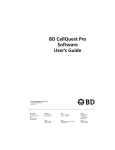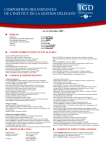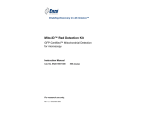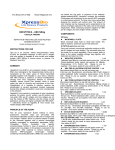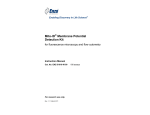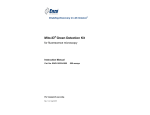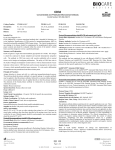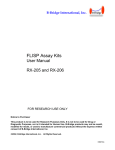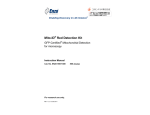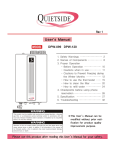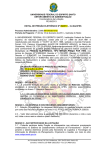Download (JC-1) 551302 - BD Biosciences
Transcript
BD™ MitoScreen
Flow Cytometry
Mitochondrial Membrane
Potential Detection Kit
Instruction Manual
Catalog No. 551302
BD flow cytometers are Class 1 laser products.
For Research Use Only. Not for use in diagnostic or therapeutic procedures.
© 2014 Becton, Dickinson and Company. All rights reserved. No part of this publication may be
reproduced, transmitted, transcribed, stored in retrieval systems, or translated into any language or
computer language, in any form or by any means: electronic, mechanical, magnetic, optical, chemical,
manual, or otherwise, without prior written permission from BD Biosciences.
Purchase does not include or carry any right to resell or transfer this product either as a stand-alone
product or as a component of another product. Any use of this product other than the permitted use
without the express written authorization of Becton, Dickinson and Company is strictly prohibited.
BD, BD Logo and all other trademarks are property of Becton, Dickinson and Company. © 2014 BD
Table of Contents
Introduction..............................................................................................4
Researching Mitochondrial Roles in Apoptosis and Other
Cellular Processes.............................................................................. 4
The BD™ MitoScreen Kit: Application of JC-1 for Flow
Cytometry .........................................................................................5
General Information: Kit Contents, Usage, and Storage.............................8
JC-1: 4 Amber Vials/Lyophilized........................................................8
10× Assay Buffer: 60 ml..................................................................... 8
Usage................................................................................................ 9
Kit Reagent Preparation...................................................................10
Dilution of 10× Assay Buffer............................................................10
Preparation of JC-1..........................................................................10
Methods for Staining Cells with JC-1 and Analyzing by Flow
Cytometry............................................................................................... 12
Staining Cells with JC-1................................................................... 12
Flow Cytometer Setup......................................................................13
Instrument Setup with BD CaliBRITE™ Beads.................................13
Multi-parameter Flow Cytometry Analysis of JC-1.......................... 13
Guidelines for Setting Gates............................................................. 14
References............................................................................................... 16
Bibliography........................................................................................... 17
Introduction
Researching Mitochondrial Roles in Apoptosis and Other
Cellular Processes
There is a burgeoning interest in the scientific community to fully define the
roles of mitochondria in cellular processes, particularly apoptosis (reviewed
in 1). Apoptosis is a complex process that can be induced by many different
factors, which, in turn, act through various cell death signaling pathways.
The role of the mitochondria could potentially vary and may be dependent
on a variety of factors including mode of apoptosis induction, cell type, or
cell status with respect to the cell cycle, state of differentiation,
development, normalcy or pathology. Two views of the mode of action are
emerging. For example, there is an abundance of data suggesting that
mitochondria play a critical role in apoptosis by releasing cytochrome c
and other proteins that are essential for the activation of pro-caspase-9 and
the execution of apoptosis. In this scenario, mitochondrial-activated
caspase-9 activates caspase-3. Caspase-3 is often referred to as the primary
executioner of apoptosis because it cleaves multiple downstream proteins
leading to a loss of cellular structure and function, and ultimately cell
death. Hence, one hypothesis supports the view that mitochondria are the
primary triggers of cell death rather than the caspases.
Other data suggest that mitochondria act more as facilitators rather than
essential players of apoptosis. For example, some signals may route to
caspase activation without first involving the mitochondria, and thereby
the activated caspases may target the mitochondria along with other
cellular components. In this model, the caspases would be the primary
triggers of cell death, and mitochondria, along with mitochondrial-linked
caspase-9, would contribute to cellular demise rather than being essential
for it. Given the complexity of apoptosis, it is likely that there are a number
of mechanisms available to the cell for carrying out the process of apoptosis
(reviewed in 2). Assays designed to evaluate the functional status of
mitochondria are emerging as useful tools for helping to elucidate
mitochondrial roles in apoptosis, the cell cycle, and other cellular processes.
Particular focus has recently been given to assays designed to study the
mitochondrial membrane potential (Δψ) during apoptosis (reviewed in 3).
Energy released during the oxidation reactions in the mitochondrial
respiratory chain is stored as a negative electrochemical gradient across the
mitochondrial membrane and the Δψ is referred to as being polarized.
Collapse of the Δψ results in a depolarized Δψ, and is often, but not always,
observed to occur early during apoptosis. For example, collapse of the Δψ
during apoptosis has been reported in a number of studies, leading to a
generalization that depolarization of the mitochondria is one of the first
events occurring during apoptosis and may even be a prerequisite for
For Research Use Only. Not for use in diagnostic or therapeutic procedures.
4
www.bdbiosciences.com
cytochrome c release. However, this generalization is now a matter of
debate and there is data indicating that collapse of the Δψ does not always
occur during apoptosis. Thus, depolarization of the Δψ may be a cause of
or be associated with apoptosis in some, but not all systems. This is
consistent with the concept that there are different mechanisms available
for cells to carry out the process of apoptosis. In addition to apoptosis,
changes in the Δψ have also been described during necrosis
(depolarization)4 and cell cycle arrest (hyperpolarization).5 Knowledge of
the Δψ and how it changes during apoptosis, necrosis, and the cell cycle
may help to clarify the role of the mitochondria in these and other cellular
processes.
The BD™ MitoScreen Kit: Application of JC-1 for Flow
Cytometry
Flow cytometry has emerged as the technique of choice for analysis of the
Δψ in whole cells.3 Membrane-permeable lipophilic cationic fluorochromes
are used as probes of Δψ; they penetrate cells and their fluorescence is a
reflection of Δψ. JC-1 (5,5',6,6'-tetrachloro-1,1',3,3'tetraethylbenzimidazolcarbocyanine iodide) is a lipophilic fluorochrome
that is used to evaluate the status of the Δψ (reviewed in 6). JC-1 stands for
1st J-aggregate-forming cationic dye found to be sensitive to the Δψ.
The fluorescence emission spectrum of JC-1 is dependent on its
concentration which, in turn, is determined by the status of the Δψ. JC-1
can exist in two different states, aggregates or monomers, each with a
different emission spectra. JC-1 forms monomers at low dye
concentrations, and aggregates at higher concentrations. Both JC-1
aggregates and monomers exhibit fluorescence in the green end of the
spectrum which is measured in the Green (FL-1) channel on flow
cytometers.
When live cells are incubated with JC-1, JC-1 penetrates the plasma
membrane of cells as monomers. Uptake of JC-1 into mitochondria is
driven by the Δψ. The Δψ of normal, healthy mitochondria is polarized and
JC-1 is rapidly taken up by such mitochondria. This uptake increases the
concentration gradient of JC-1 leading to the formation of JC-1 aggregates
(known as J-aggregates) within the mitochondria. JC-1 aggregates show a
red spectral shift resulting in higher levels of red fluorescence emission
which is measured in the Red (FL-2) channel on most flow cytometers.7
For Research Use Only. Not for use in diagnostic or therapeutic procedures.
www.bdbiosciences.com
5
Although, JC-1 fluorescence is seen in both the FL-1 and FL-2 channels in
healthy cells, the pattern of JC-1 staining may vary between cell type or cell
line. For example, the mitochondria of cardiac muscle cells are more
polarized than those in bladder epithelial cells and have brighter red
fluorescence. In addition to mitochondrial heterogeneity between cell lines,
intercellular heterogeneity within a cell population may exist.6 Therefore,
the level of brightness in the FL-2 channel can vary both between and
within cell types and lines.
JC-1 does not accumulate in mitochondria with depolarized Δψ and
remains in the cytoplasm as monomers. These monomers do not have the
red spectral shift, and therefore have lowered fluorescence in the FL-2
channel. The formation of JC-1 aggregates is reversible. Thus, in
mitochondria undergoing a transition from polarized to depolarized Δψ
(due to apoptosis or other physiological events), JC-1 leaks out of the
mitochondria into the cytoplasm as monomers resulting in a decrease of
red fluorescence.
The majority of cells in healthy cultures will have a polarized Δψ, and
hence show JC-1 fluorescence in both the FL-1 and FL-2 channels (Figure
1, A-C). It is likely that there will be a small population of cells that has
significantly reduced FL-2 fluorescence. JC-1 that fluoresces in the FL-1
channel and lacks fluorescence in the FL-2 channel is indicative of
depolarized Δψ. Depolarized Δψ indicates altered mitochondrial function
which may be due to apoptosis or other cellular processes. The percentage
of cells showing reduced fluorescence in the FL-2 channel may vary
depending on the cell type and culture system. However, a large percentage
of cells with reduced fluorescence in the FL-2 channel in normal or control
cultures may indicate that the health of the culture has been compromised.
For Research Use Only. Not for use in diagnostic or therapeutic procedures.
6
www.bdbiosciences.com
Mouse Thymocytes
Jurkat T Cells
R1
R2
JC-1 (FL-2)
Control
Control
B
A
Staurosporine
D
C
R1
R1
R2
R2
Camptothecin
Fas mAb
F
E
R1
R1
R1
R2
R2
R2
JC-1 (FL-1)
Figure 1. JC-1 Staining in Control and Apoptotic Cells. Cells (1 × 106 cells/ml) were
left untreated (vehicle only, A-C) or treated with staurosporine (1µm, 4 h),
camptothecin (4 µm, 4 h), or Fas mAb [clone Jo2, Cat. No. 554254 (2 µg/ml) and
Protein G* (2 µg/ml), 1.5 h] to induce apoptosis (D-F). Cells were stained with JC-1
according to the protocol and analyzed on a BD FACSCalibur™ as described in the
section Methods for Staining Cells with JC-1 and Analyzing by Flow Cytometry.
(A-C) JC-1 fluorescence is seen in both the FL-2 and FL-1 channels (R1) in the
control (untreated) cell populations. A small percentage of the population shows
decreased fluorescence in the FL-2 channel (R2). (D-F) There is a significant
increase in the number of cells with lowered red fluorescence [FL-2 (R2)], indicative
of a change in the Δψ, in the populations induced to undergo apoptosis. JC-1 that
fluoresces in both the FL-2 and FL-1 channels is considered to correspond to
mitochondria with a polarized Δψ. JC-1 that fluoresces in the FL-1 channel and
lacks fluorescence in the FL-2 channel is considered to correspond to mitochondria
with a depolarized Δψ. Thus, the data indicates that apoptosis induction was
associated with depolarization of the Δψ.
*The addition of Protein G enhances the ability of Jo2 to induce apoptosis,
presumably by cross-linking Fas receptors.
Apoptosis is frequently associated with depolarization of the Δψ, resulting
in increased numbers of cells with reduced JC-1 fluorescence in the FL-2
channel (Figure 1, D-F). That is, the apoptotic population frequently
presents a lower red fluorescence signal intensity (FL-2 axis) than the
negative control population. In some apoptotic systems, changes in the
level of green fluorescence measured in FL-1 has also been observed. It is
not clear how these changes relate to changes in the level of membrane
polarization or apoptosis.
For Research Use Only. Not for use in diagnostic or therapeutic procedures.
www.bdbiosciences.com
7
The BD™ MitoScreen Kit contains JC-1, which has been optimized for use
in flow cytometry, and 10× Assay Buffer. JC-1 is typically excited using the
488 nm line of an argon ion laser. JC-1 monomers emit maximally at 527
nm and aggregates at 590 nm. In the existing literature, a number of ways
have been used to set up flow cytometers for measurement of the FL-1 and
FL-2 channels. Factors which can be varied include the PMT settings for
each channel and the amount of compensation.
Data may appear differently depending on how the machine is set up. In
this manual we provide a standardized approach to allow for reproducible
instrument set up. Representative data obtained using the approach
described herein is shown in Figure 1. A partial list of publications
containing figures with additional JC-1 flow cytometry data is provided in
the section JC-1 Bibliography. Given potential differences in instrument
settings, data obtained using the standardized set up may appear to be
different from previously published data.
General Information: Kit Contents, Usage, and Storage
The BD™ MitoScreen Kit is designed for use in flow cytometry. It consists
of two reagents, JC-1 and 10× Assay Buffer. JC-1 excites at 488 – 490 nm.
The monomeric form emits at 527 nm; J-aggregates emit at 590 nm. There
are enough reagents to test 100 samples by flow cytometry using the
protocol provided. Store the unopened vials of JC-1 and 10× Assay Buffer
at 2°C – 8°C.
JC-1: 4 Amber Vials/Lyophilized
There is enough JC-1 in each vial for 25 flow cytometry tests. JC-1 is
supplied in amber vials because it is light sensitive. JC-1 is reconstituted
prior to use, first into a Stock Solution and then into a Working Solution.
10× Assay Buffer: 60 ml
The 10× Assay Buffer is supplied in excess of what is generally needed for
100 flow cytometry tests. The 10× Assay Buffer is diluted to 1× prior to
use.
Please refer to the section Kit Reagent Preparation for details on
reconstitution of JC-1 and dilution of 10× Assay Buffer, and to Diagram 1
for an overview of reagent preparation and subsequent JC-1 staining.
For Research Use Only. Not for use in diagnostic or therapeutic procedures.
8
www.bdbiosciences.com
10 ml
125 μl
90 ml
100 ml
60 ml
125 μl
10X Assay
Buffer
1X Assay
Buffer
DI H20
1X Assay
Buffer
12.375 ml
DMSO
125 μl
12.5 ml
JC-1 vial,
lyophilized
JC-1 Stock Solution
(reconstituted)
JC-1 Stock Solution
(reconstituted)
12.5 ml JC-1 Working Solution for
25 flow cytometry samples (0.5 ml/sample)
JC-1 Working Solution
Cell sample
(≤1x106 cells)
Add 0.5 ml JC-1 Working Solution/sample
(Incubate for 10-15 min @ 37˚C in CO2 incubator)
Wash each sample with 2.0 ml of 1X Assay Buffer @ RT
Wash each sample with 1.0 ml of 1X Assay Buffer @ RT
Resuspend each sample in 0.5 ml of 1X Assay Buffer
Analyze by flow cytometry
Diagram 1. Overview of Reagent Preparation and JC-1 Staining Protocol. This
diagram summarizes the reconstitution of the BD™ MitoScreen Kit components
and sample preparation. Please refer to the manual for details.
Usage
The BD™ MitoScreen Kit is compatible with a wide variety of cell model
systems and treatment protocols. In flow cytometric applications utilizing
intact cells, JC-1 has typically been used to study relationships between
apoptosis and Δψ. Most of the published literature utilizing the flow
cytometry application has been focused on using JC-1 to study the effects
of apoptosis on Δψ.
For Research Use Only. Not for use in diagnostic or therapeutic procedures.
www.bdbiosciences.com
9
There are numerous ways to induce apoptosis and each researcher may
need to optimize protocols for their own experimental system. Researchers
are strongly encouraged to refer to the extensive literature for information
regarding different protocols that have been used to induce apoptosis. The
optimal protocol for inducing apoptosis may be cell line dependent.
It is important to note apoptosis may be present in the absence of observed
changes in JC-1 fluorescence. This is because depolarization of the Δψ does
not always occur during apoptosis or may not be present at the time point
examined. Researchers are encouraged to complement their JC-1 studies
with other apoptosis assays to gain additional information about the status
of their model system.
Kit Reagent Preparation
The 10× Assay Buffer is diluted to a 1× solution prior to use; and JC-1 is
reconstituted into a Stock Solution and then diluted to a Working Solution
prior to use (Diagram 1).
Dilution of 10× Assay Buffer
The Assay Buffer is formulated for use as reaction buffer, and for washing
the cells. It is supplied as a 10× concentrate which must be diluted to 1×
with DI H20 prior to use.
1. To completely dissolve any salt crystals that may have come out of
solution, gently warm the 10× Assay Buffer in a 37°C water bath.
2. Dilute the 10× Assay Buffer 1:10 in DI H2O. For example, add 10 ml
10× Assay Buffer to 90 ml DI H2O.
3. Stir the solution for 5 min.
4. Warm the 1× Assay Buffer to 37°C prior to use.
Note:
We recommend diluting only the amount of 10× Assay Buffer
that will be used in a given day. However, unused diluted (1×)
assay buffer may be stored for up to 7 days at 2°C – 8°C.
Preparation of JC-1
JC-1 is supplied lyophilized. It is first prepared as a Stock Solution and then
used as a Working Solution. The JC-1 Stock Solution may be aliquoted and
stored at –20°C. The Working Solution, prepared from the Stock Solution,
must be used immediately after preparation and cannot be stored.
For Research Use Only. Not for use in diagnostic or therapeutic procedures.
10
www.bdbiosciences.com
Preparation of JC-1 Stock Solution (one vial)
1. Reconstitute the lyophilized JC-1 reagent at room temperature with
125 µl DMSO (per vial) to yield a JC-1 Stock Solution. Re-cap the vial
and invert several times to fully dissolve the reagent.
2. The Stock Solution must be used immediately by diluting into a
Working Solution (see Preparation of JC-1 Working Solution from
Stock Solution) or aliquoted into amber vials (to protect against light)
and stored at –20°C (for up to six months).
3. Avoid repeated freeze/thaws of individual vials of JC-1 Stock Solution
as this may compromise its integrity. Hence, we recommend that when
making aliquots of JC-1 Stock Solution for freezing, that each aliquot
contains only the amount that will likely be needed at the time of
thawing.
Note:
The kit contains 4 vials of lyophilized JC-1 reagent and we
recommend reconstituting only the amount of vials needed
for a given experiment
Preparation of JC-1 Working Solution from Stock Solution
1. Warm the 1× Assay Buffer to 37°C.
2. Prepare a 1× JC-1 Working Solution by diluting the JC-1 Stock
Solution 1:100 with prewarmed 1× Assay Buffer. For example, add
125 µl JC-1 stock to 12.375 ml of prewarmed assay buffer. 0.5 ml
JC-1 Working Solution is required for each sample (cell pellet
containing < 1 × 106 cells). Therefore, 12.5 ml JC-1 Working
Solution would be enough for 25 flow cytometry samples.
3. Vortex the JC-1 Working Solution thoroughly.
4. After vortexing, particulate matter consisting of JC-1 aggregates
may be present. This should not interfere with flow cytometric
analysis. However, if desired, the solution can be clarified by
centrifugation at 13,000 × g in a microfuge for 3 min, or 15 min in
a centrifuge at 1,000 × g at RT. Transfer the clarified supernatant to
a clean tube and discard particulates.
5. The JC-1 Working solution must be used immediately after
preparation. Proceed to the section Methods for Staining Cells with
JC-1 and Analyzing by Flow Cytometry for JC-1 staining and
analysis protocols. Discard leftover JC-1 Working Solution, do not
store.
For Research Use Only. Not for use in diagnostic or therapeutic procedures.
www.bdbiosciences.com
11
Methods for Staining Cells with JC-1 and Analyzing by
Flow Cytometry
An overview of staining cells with JC-1 for use in flow cytometry is illustrated
in Diagram 1. Details for staining and flow cytometric analysis follow.
Staining Cells with JC-1
1. Culture cells to an optimal density. Typically, cell density in the cell
culture flasks should not exceed 1 × 106 cells per ml. Cells
cultivated in excess of this concentration may begin to naturally
enter apoptosis. Optimal cell concentration will vary depending on
the cell line used. Concentration can be determined by counting cell
populations on a hemocytometer.
2. Proceed with treatment of choice (eg, apoptosis induction) or leave
untreated.
3. At the end of the treatment period, transfer 1 ml of each cell
suspension into a sterile 15 ml polystyrene centrifuge tube.
4. Centrifuge cells at 400 × g for 5 minutes at RT. Carefully remove
and discard the supernatant.
5. Add 0.5 ml of freshly prepared JC-1 Working Solution to each
pellet. Gently resuspend cells in the JC-1 Working Solution. Vortex
or use a pipette to disrupt any cell-to-cell clumping.
6. Incubate the cells in JC-1 Working Solution for 10 – 15 min at 37°C
in a CO2 incubator. Wash cells twice following incubation (see
below; wash steps are performed at RT).
7. 1st wash: Add 2 ml of 1× Assay Buffer to each tube and gently
resuspend cells. Vortex or use a pipette to disrupt any cell-to-cell
clumping.
8. Centrifuge cells at 400 × g for 5 min.
9. Carefully remove and discard supernatant.
10. 2nd wash: Add 1 ml of 1× Assay Buffer to each tube and gently
resuspend cells. Vortex or use a pipette to disrupt any cell-to-cell
clumping.
11. Centrifuge the cells at 400 × g for 5 min.
12. Gently resuspend each cell pellet in 0.5 ml of 1× Assay Buffer.
Vortex or use a pipette to disrupt any cell-to-cell clumping.
13. Analyze cells by flow cytometry (see Multi-Parameter Flow
Cytometry Analysis of JC-1).
For Research Use Only. Not for use in diagnostic or therapeutic procedures.
12
www.bdbiosciences.com
Flow Cytometer Setup
The Cytometer setup information in this section is designed for the BD
FACScan™, BD FACSort™, and BD FACSCalibur flow cytometers. The
BD FACSComp™ software is used for setting up the flow cytometers.
Compensation for FL-1/FL-2 should be set up using BD CaliBRITE™
beads (Cat. No. 349502).
Instrument Setup with BD CaliBRITE™ Beads
Start-up
the instrument
Perform
flow check
Prepare
tubes of BD CaliBRITE™ beads
Launch
BD FACSComp™ software
Run
Note:
BD FACSComp™ using the lyse/no wash procedure.
For detailed information on using BD FACSComp with
BD CaliBRITE beads to set up the flow cytometer, refer to the
BD FACSComp Software User’s Guide and the BD CaliBRITE
Beads Package Insert.
Multi-parameter Flow Cytometry Analysis of JC-1
As noted earlier there are a large number of factors that can affect JC-1
fluorescence emission, both with respect to absolute intensity in the Green
(FL-1) and Red (FL-2) channels and to the ratio of the two channels. Figure
1 shows the results of 3 different experiments done on different days each
analyzed using the instrument setup described in the section Flow
Cytometer Setup. Each experiment consists of a healthy control (untreated)
population and a population induced to undergo apoptosis. Major
populations (R1) are identified as FL-1 bright, FL-2 bright in the healthy
controls, indicative of polarized Δψ. Minor populations are identified that
have decreased fluorescence in the FL-2 channel (R2) and are FL-1 bright,
FL-2 dull, indicative of depolarized Δψ. These observations are consistent
with the notion that mitochondria in control cells are primarily healthy and
functioning normally (polarized Δψ). The small percentage of the control
population of cells with depolarized Δψ may reflect a basal level of
apoptosis or presence of other cellular processes that are associated with
depolarized Δψ.
For Research Use Only. Not for use in diagnostic or therapeutic procedures.
www.bdbiosciences.com
13
The fluorescence pattern of JC staining differs dramatically even on healthy
control cells (Figure 1, A-C). For example, a comparison of the major
populations (R1) in Figure 1A (human Jurkat cells) and C (primary mouse
thymocytes) shows that the control Jurkat cells show lower fluorescence
intensity in both the FL-1 and FL-2 channels. The pattern can even be
different using the same cell type on different days (compare A and B).
There is a significant increase in the number of cells with lowered red
fluorescence [FL-2 (R2)] in the apoptotic compared to the corresponding
control populations (compare Figure 1, D-F to A-C, respectively). These
results are consistent with the notion that apoptosis is often associated with
a transition from polarized to depolarized Δψ.
Guidelines for Setting Gates
As the pattern of JC-1 staining can vary, it is not possible to provide users
with universal guidelines for how to set gates for healthy, non-apoptotic
{FL-1bright, FL-2bright; R1} and apoptotic {FL-1bright, FL-2dull; R2}
cells. Each user will have to define the appropriate gates for their
experimental model system of apoptosis. The following are some guidelines
that will help set appropriate gates.
1. Given the variability it is critical that whenever possible, positive
(induced apoptotic) and control (untreated) samples be included in
every experiment for every cell type. In preliminary experiments it is
strongly recommended that the presence (in the induced sample) or
absence (in the control sample) of apoptotic cells be supported by an
alternative apoptosis assay such as Annexin V or Active Caspase 3.
These products are available in a number of formats; please visit
www.bdbiosciences.com for more information on our full line of
apoptosis products.
2. The R1 (non-apoptotic cell) gate should be set to encompass the major
population(s) in the control sample. Figure 1 A-C show the gates set
for three different experiments. The shape and placement of the gate
will vary from cell type to cell type. Generally, there is clearly a single
major distinct population of FL-1 bright, FL-2 bright cells as in Figure
1 A and B. However, because the shape and size of the R1 gate can vary
on different days, direct comparisons between similar cell types using
this approach should be carried out on the same day.
For Research Use Only. Not for use in diagnostic or therapeutic procedures.
14
www.bdbiosciences.com
In some cases the boundaries of the major population may be harder to
define, making the division between FL-1 bright, FL-2 bright and FL-1
bright, FL-2 dull more arbitrary, as is shown in C. In these cases, it is
particularly critical to define the approximate percentage of apoptotic cells
through alternative assays.
3. Since apoptotic cells typically lose JC-1 fluorescence in the
FL-2 channel the R2 (apoptotic cell) gate is drawn to
encompass the area directly below the R1 gate as shown
in Figure 1 A-C. The accuracy of these gates is best
confirmed using the positive induced sample with
demonstrable apoptotic cells (Figure 1, D-F).
4. Once the appropriate R1 and R2 gates have been
determined using the control and treated samples they
should be maintained throughout all samples of
equivalent cell types for that experiment on a given day.
5. As the user becomes familiar with their experimental
system they may wish to set up gating templates that can
be individually adjusted for each experiment. It should
always be kept in mind, that the actual Δψ JC-1 staining
profile seen in a given population, control or treated, may
depend on a variety of factors, including the model
system, the cell type, the overall health of the cell culture,
and treatment type or time.
For Research Use Only. Not for use in diagnostic or therapeutic procedures.
www.bdbiosciences.com
15
References
1. Finkel, E. 2001. The mitochondrion: Is it central to apoptosis?
Science 292:624 - 626.
2. Leist, M., and M. Jaattela. 2001. Four deaths and a funeral: from
caspases to alternative mechanisms. Nature Rev Mol Cell Biol.
2:589-598.
3. Darzynkiewicz, Z., E. Bedner, and P. Smolewski. 2001. Flow cytometry
in analysis of cell cycle and apoptosis. Seminars Hematol. 38:179-193.
4. LeMasters, J.J., A.L. Nieminen, T. Qian, L.C. Trost, S.P. Elmore,
Y. Nishimure, R.A. Crowe, W.E.. Cascio, D.A. Brenner, and
B. Herman. 1998. The mitochondrial permeability transition in cell
death: A common mechanism in necrosis, apoptosis, and autophagy.
Biochim. Biophys. Acta. 1366:177-196.
5. Facompre, M., N. Wattez, J. Kluza, A. Lansiaux, and C. Bailly. 2000.
Relationship between cell cycle changes and variations of the
mitochondrial membrane potential induced by etoposide.
Mol. Cell Biol. Res. Comm. 4:37-42
6. Reers, M., S.T. Smiley, C. Mottola-Hartshorn, A. Chen, M. Lin, and
L.B. Chen. 1995. Mitochondrial membrane potential monitored by
JC-1 dye. Methods Enzymol. 260:406-417.
7. Cossarizza, A., M. Baccarani-Contri, G. Kalashnikova, and
C. Franceschi. 1993. A new method for the cytofluorimetric analysis of
mitochondrial membrane potential using the J-aggregate forming
lipophilic cationic 5,5',6,6'-tetrachloro-1,1',3,3'tetraethylbenzimidazolcarbocyanine iodide (JC-1). Biochem. Biophs.
Res. Comm. 197:40-45.
For Research Use Only. Not for use in diagnostic or therapeutic procedures.
16
www.bdbiosciences.com
Bibliography
The following is a partial list of publications containing figures with cells stained with
JC-1 and analyzed by flow cytometric analysis.
1. Cossarizza, A., M. Baccarani-Contri, G. Kalashnikova, and
C. Franceschi. 1993. A new method for the cytofluorimetric analysis of
mitochondrial membrane potential using the J-aggregate forming
lipophilic cationic 5,5',6,6'-tetrachloro-1,1',3,3'tetraethylbenzimidazolcarbocyanine iodide (JC-1). Biochem. Biophs.
Res. Comm. 197:40-45.
Model system: U937 and K562 cells treated with valinomycin
2. Petit, P.X., H. Lecoeur, E. Zorn, C. Dauguet, B. Mignotte, and
M-L. Gougeon. 1995. Alterations in mitochondrial structure and
function are early events of dexamethasone-induced thymocyte
apoptosis. J. Cell Biol. 130:157-167.
Model system: mouse thymocytes treated with dexamethasone
3. Salvioli, S., Ardizzoni, A., Franceschi, and A. Cossarizza 1997. JC-1,
but not DiOC6(3) or rhodamine 123, is a reliable fluorescent probe to
assess Δψ changes in intact cells: implications for studies on
mitochondrial functionality during apoptosis. FEBS 411:72-82.
Model system: U937 cells treated with ouabain, KCl, valinomycin, or FCCP
4. Barbieri, D., M.P. Abbracchio, S. Salvioli, D. Monti, A. Cossarizza,
S. Ceruti, R. Brambilla, F. Cattabeni, K.A. Jacobson, and
C. Franceschi. 1998. Apoptosis by 2-chloro-2'-deoxyadenosine and
2-chloro-adenosine in human peripheral blood mononuclear cells.
Neurochemi. Int. 32:493-504.
Model system: human peripheral blood mononuclear cells treated with 2-chloroadenosine and 2-chloro-2'-deoxy-adenosine
5. Facompre, M., N. Wattez, J. Kluza, A. Lansiaux, and C. Bailly. 2000.
Relationship between cell cycle changes and variations of the
mitochondrial membrane potential induced by etoposide. Mol. Cell
Biol. Res. Comm. 4:37-42.
Model system: HL-60 cells treated with etoposide
6. Gravance, C.G., D.L. Garner, J. Baumber, and B.A.Ball. 2000.
Assessment of equine sperm mitochondrial function using JC-1.
Theriogenology 53:1691-1703
Model system: equine spermatozoa
For Research Use Only. Not for use in diagnostic or therapeutic procedures.
www.bdbiosciences.com
17
7. Mathur, A., Y. Hong, B.K. Kemp, A.A. Barrientos, and J.D.
Erusalimsky. 2000. Evaluation of fluorescent dyes for the detection of
mitochondrial membrane potential changes in cultured
cardiomyocytes. J. Cardiovascular Res. 46:126-138.
Model system: rat cardiomyocytes
8. Mantymaa, P., T. Sitonen, T. Guttorm, M. Saily, V. Kinnula, E-R.
Savolainen, and P. Koistinen. 2000. Introduction of mitochondrial
manganes superoxide dismutase confers resistance to apoptosis in
acute myeloblastic leukemia cells exposed to etoposide. British J.
Haematol. 108:574-581.
Model system: acute myeloblastic leukemia cell line (OCI/AML-2) subclones treated
with etoposide
9. Salvioli, S.,k J. Dobrucki, L. Moretti, L. Troiano, M.G. Fernandez,
M. Pinti, J. Pedrazzi, C. Franceshi, and A. Coassarizza. 2000.
Mitochondrial heterogeneity during staurosporine-induced apoptosis
in HL60 cells: Analysis at the single cell and single organelle level.
Cytometry 40:189-197.
Model system: HL60 cells treated with staurosporine
For Research Use Only. Not for use in diagnostic or therapeutic procedures.
18
www.bdbiosciences.com
Notes
For Research Use Only. Not for use in diagnostic or therapeutic procedures.
www.bdbiosciences.com
19
United States
877.232.8995
Canada
866.979.9408
Europe
32.2.400.98.95
Japan
0120.8555.90
Asia/Pacific
65.6861.0633
Latin America/Caribbean
55.11.5185.9995
Becton, Dickinson and Company
BD Biosciences
2350 Qume Dr.
San Jose, CA 95131 USA
(US) Ordering 855.236.2772
Technical Service 877.232.8995
Fax 800.325.9637
bdbiosciences.com
[email protected]
Catalog No. 551302
Rev# 3






















